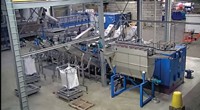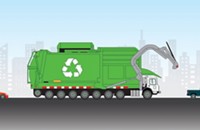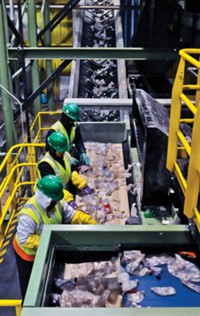Advertisement
Grab your lab coat. Let's get started
Welcome!
Welcome!
Create an account below to get 6 C&EN articles per month, receive newsletters and more - all free.
It seems this is your first time logging in online. Please enter the following information to continue.
As an ACS member you automatically get access to this site. All we need is few more details to create your reading experience.
Not you? Sign in with a different account.
Not you? Sign in with a different account.
ERROR 1
ERROR 1
ERROR 2
ERROR 2
ERROR 2
ERROR 2
ERROR 2
Password and Confirm password must match.
If you have an ACS member number, please enter it here so we can link this account to your membership. (optional)
ERROR 2
ACS values your privacy. By submitting your information, you are gaining access to C&EN and subscribing to our weekly newsletter. We use the information you provide to make your reading experience better, and we will never sell your data to third party members.
Business
Genie in the Bottle
PET makers wish for new bottle markets, lower feedstock costs, and better market conditions
by ALEXANDER H. TULLO, C&EN NORTHEAST NEWS BUREAU
June 21, 2004
| A version of this story appeared in
Volume 82, Issue 25
Clear and strong, versatile and recyclable, it is no wonder that polyethylene terephthalate resin has become a consumer favorite and has enjoyed so much success. Few high-volume polymers enjoy such growth. Even in the developed world, demand for PET is still growing at close to double-digit rates.
But this fortunate son of the plastics industry isn't without its flaws. PET resin is joined at the hip with polyester fiber. That, plus the construction of ever-larger plants, has led to oversupply. PET producers have weathered high raw material costs like the rest of the chemical industry. And new markets like beer that push PET's technical limits haven't come as easily as the 20-oz soft drink bottle did years ago.
Acknowledging these challenges, some observers whisper the word "commoditization"; others concede that PET growth rates are ebbing in some parts of the world.
According to Edgar Acosta, a polyester resin and fibers consultant with Houston-based DeWitt & Co., the U.S. market for PET resin is 3.1 million metric tons per year, about a third of global demand. Growth in North America was 8% last year, Acosta says, lackluster for a plastic that grew at double-digit rates in the 1990s. This year, he predicts, growth will be 1 to 2% less. "We reached a point of saturation in terms of the market channels in water and soda," he says.
Observers in the industry are more optimistic. Tom Sherlock, business director for DAK Resins, says unseasonably chilly weather last summer in major U.S. soft drink markets like New York City accounted for the sluggish demand in 2003.
Sherlock says growth in 2004 has improved, and he forecasts an 8.5% expansion for the year. In part, the growth will come from soft drink brands being launched this summer, such as the new "C2" low-carbohydrate version of Coca-Cola, even though they will largely cannibalize other PET-bottled soft drinks. "There are people who are not drinking carbonated soft drinks right now who might try them," he says.
Although carbonated soft drink markets are maturing in North America, there is still some growth left in hot-fill applications like juices. Michael E. Dewsbury, vice president of PET resins at Wellman, says the interest will expand as improved bottle design and polymer architecture allow PET to be used at higher temperatures.
And PET still has the potential to return to huge growth if its luck changes in markets that have so far been elusive--notably beer, which has been called the Holy Grail of PET for nearly a decade.
Kevin M. Fogarty, president of polymers and resins at Invista--the name for the combined entity of Invista and the former KoSa polyester business following Koch's purchase of Invista from DuPont--says the beer bottle market is so large that every 1% of penetration by PET translates into a 1% increase in operating rates at PET plants.
Producers debate why plastic beer bottles aren't common. Dewsbury suggests it's marketing strategy. Consumers, he says, rejected brewers' efforts to market long-neck PET beer bottles. Beer in PET did find a niche in sporting venues, he notes, but in few other places in the U.S.
Dewsbury says larger 22- and 40-oz beer bottles, where aesthetics aren't as important, would have been a more worthwhile target. "Beer companies might have had more success if they had gone after convenience store packaging," he says.
Invista's Fogarty thinks technology is the reason PET hasn't caught on in beer yet. PET, by itself, doesn't provide enough of an oxygen barrier to be an effective beer container. As a result, PET beer bottles need additional barrier layers of nylon, plasma-applied coatings, or polyethylene naphthalate that raise production costs. "It was clear to us all along that the issue was not consumer acceptance," he says.
Fogarty says these costs won't come down until PET makers can develop suitable oxygen barrier properties in a single layer. "In order to get the costs similar to carbonated soft drink bottles, you have to eliminate process steps," he says. To that end, Invista in January introduced PolyShield, a resin the company says can enable monolayer beer bottles. It will be used in a European beer brand this fall.
THE PET INDUSTRY also has its sights trained on aluminum soft drink cans, a 60 billion-unit-per-year market, according to Wellman's Dewsbury. "The largest single opportunity for growth in the U.S. is the replacement of the 12-oz can," he says.
Dewsbury has no doubt that 12-oz PET bottles are better than cans, owing to appearance and resealability. He says it has been hard for plastic to make headway into the market because aluminum is so entrenched. "If PET bottles had existed in their current format 30 years ago, cans would not exist in carbonated soft drinks today," he notes.
PET wasn't ready, he says, and soft drink companies have since built a manufacturing infrastructure around cans that they have little incentive to replace.
However, Dewsbury notes that 12-oz PET bottles are making headway. Although soft drink companies have spent a lot on can-filling capacity, he says they are no longer investing in cans and are opting for 12-oz PET for new growth. "It has been difficult, but PET does dislodge aluminum a little each year," he says.
Producers say conventional uses for PET are still growing outside of North America, particularly as higher raw material costs level the playing field between the U.S. and Asia. "Historically, Asian producers have had a raw material price advantage that allowed them to become significant exporters," DAK's Sherlock says. "Now they have to purchase raw materials at basically the same price as North American PET producers."
Dewsbury says Asia's advantage extended beyond feedstocks. He claims that countries like Taiwan, Thailand, India, and Indonesia do not have an inherent cost advantage in PET resins because, unlike fibers, polymer production isn't labor intensive. However, high tariffs erected by these countries enable local manufacturers to sell PET domestically at inflated prices while exporting it below cost, he says. "They subsidize their exports to the U.S. by their home market sales."
U.S. PET producers have filed complaints with the International Trade Commission about the practice. European rulings against Asian producers, DeWitt's Acosta says, are already paying off for U.S. producers, who are now more competitive in exporting to Europe. "Normal export channels are starting to shift," he says.
U.S. producers may also be able to take advantage of growth in the developing world, particularly Latin America. Conversions of most of the easier applications for PET are complete in the U.S., but not in Mexico, Dewsbury points out. "And per capita consumption of soft drinks in Mexico exceeds the U.S. That is a huge market potential."
Last year, Mossi & Ghisolfi Group, which purchased Shell Chemical's PET business in 2000, completed a 275,000-metric-ton-per-year plant, the world's largest single-stream PET facility, in Altamira, Mexico. M&G says the plant is running above its designed capacity and that the company is expanding the plant to 440,000 metric tons this year.
M&G, which in 2002 purchased Brazilian PET producer Rhodia-ster, is also considering a plant in Recife, Brazil. Acosta says the South American market is growing at a 14% annual clip.
While fortunes for U.S. makers are improving, Sherlock says their situation still isn't prosperous. "The good news for PET is that there's reasonable growth," he says. "The bad news is that it is an extremely competitive business. Over the past three years, profits have been either nonexistent or slim. Rapid raw material cost increases have taken margin out of the industry, and the planned expansions on top of that have contributed to the problem."
A year ago, Sherlock's company doubled the capacity of its Cooper River, S.C., plant to 300,000 metric tons. The expansion was a conversion of a polyester fiber plant to produce PET resin. Such a project involves the addition of a solid-state polymerization line to boost the molecular weight of the melt-phase polymer that comes out of the main polymerization reactor and that is otherwise extruded into polyester fiber.
Dewsbury says conversions like DAK's have been a common response to the U.S. textile industry's decline in the face of Asian competition. Yet there is still a lot of melt-phase polyester capacity that can be upgraded into PET resin.
Wellman started up a fiber line in Pearl River, Miss., in 2000, just when the polyester fiber market started to tumble. The company idled the unit soon after and quickly slated it for conversion into a 140,000-metric-ton PET unit. However, given poor market conditions in PET, the firm never went through with the project. Now the project is slated for 2006. Other companies, like Invista and DAK, say they also have polyester fiber capacity that can be converted.

MAKING THE SWITCH costs money, and Dewsbury doesn't think the U.S. market will be mired in overcapacity because of fiber line conversion. However, Acosta says the conversions cost only about a third as much as brand-new PET lines. He worries that conversions, plus huge PET plants like the one M&G recently started up, are transforming the value-added plastic into a price-driven commodity. "There is a significant drop in the cost of making this stuff," he says. "We are marching toward commoditization ahead of schedule."
Capacity is also being taken out of the marketplace. In April, M&G closed a 100,000-metric-ton line in Apple Grove, W.Va. At the time, Fred Fournier, M&G's global sales and marketing director, had harsh words for both customers and raw materials suppliers. "The closure is regrettable but has been forced by the current business environment, where feedstock suppliers are showing little consideration for the needs of the PET industry, particularly in North America, and the stubborn brand owners are failing to share the higher chain costs or to pass through the increases to final consumers," he said.
"As an industry leader," Fournier added, "we have decided to make it clear that we will not continue to subsidize the obvious disconnect between the behaviors of feedstock suppliers and brand owners."
Thomas J. Stevens, group vice president of Eastman Chemical's polymers business group, tactfully agrees. "Raw material prices have remained strong and volatile in 2004, requiring that these increased costs be passed on to customers," he says. "Resin price increases have offset part of, though not all of, the raw material pressures."
Stevens points out that in response to the escalating costs, Eastman, too, has undergone restructuring. It is closing a specialty copolyester site in Hartlepool, England, and shifting production to plants in Kingsport, Tenn., and Kuantan, Malaysia. "Obviously, neither we nor our customers are pleased with the current situation."
However, Stevens says the situation is getting better. He says the market hit bottom at the turn of the year and that the recovery will be well under way this year. If feedstock costs ease, the industry may even be profitable this year. And if more markets like beer and smaller carbonated beverage bottles come into play, the recovery may be sustained for years to come.
MORE ON THIS STORY
POLYMERS' PLIGHT
Expensive feedstocks have put profits on hold for makers of high-volume polymers
GENIE IN THE BOTTLE
PET makers wish for new bottle markets, lower feedstock costs, and better market conditions






Join the conversation
Contact the reporter
Submit a Letter to the Editor for publication
Engage with us on Twitter